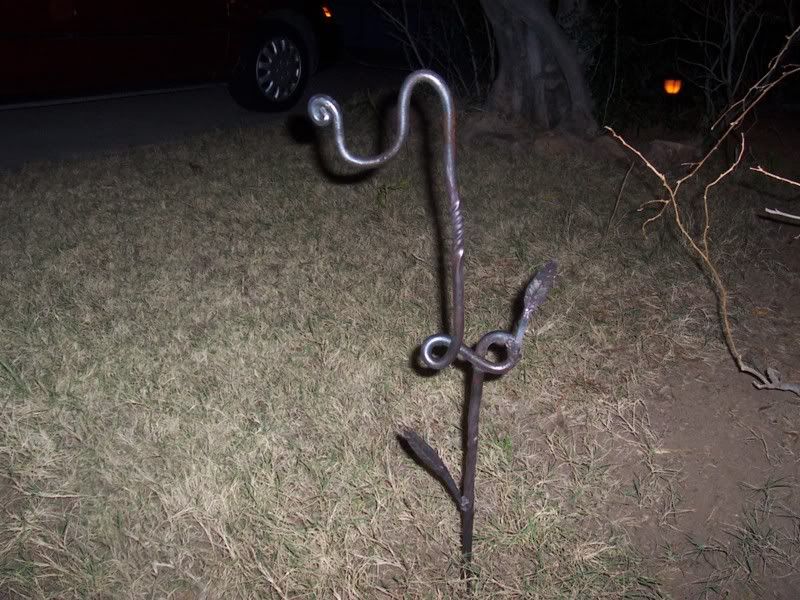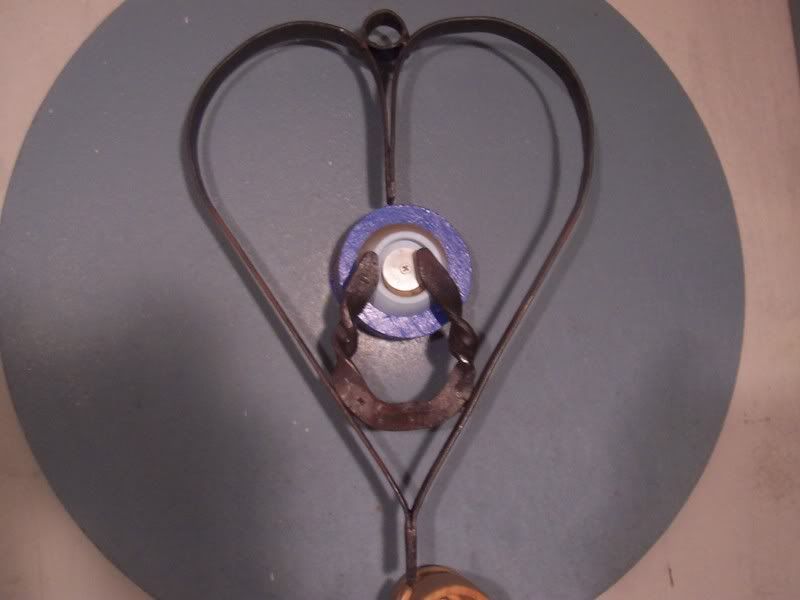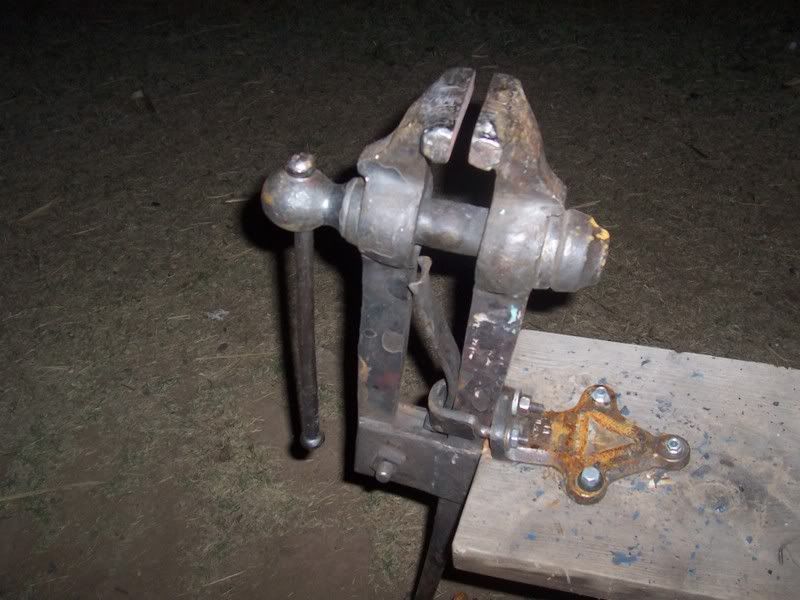-
Posts
370 -
Joined
-
Last visited
Content Type
Profiles
Forums
Articles
Gallery
Downloads
Events
Posts posted by julian
-
-
that anvil is so pretty i could kiss it's face
 My anvil has a rounded bending corner so it wont chip or ding up the steel you're working.
My anvil has a rounded bending corner so it wont chip or ding up the steel you're working. -
Bienvenue dav! Je m'appelle Julian, je viens d'Arizona

I also like knives, they're a lot of fun to tinker with. Good to have another smith from France on here, Iforgeiron is getting bigger every day!
Happy Smithing! -
definitely look at the blueprints or how-to's on this website cooter. Don't worry about being too old to start blacksmithing, I've only been tinkering around with hot metal for 3 years and have half decent work coming out of my shop. If I can do it I'm sure you could

I'm not 100% sure, but I think that the metal heating bar things on the inside of ceramic kilns are electrified when turned on. Those kilns *might* get to forging temperature, but it would sorta be like trying to dissolve a block of salt by spitting on it as opposed to throwing it in a pool. What you want is a relatively small concentrated source of heat; in this case a forge would work. All a forge really is is a fire with air blowing through it. My first forge was a firepit in the ground with a vacuum cleaner blowing on it, and it got steel to a dull orange. Building them isn't too hard, you could probably get one welded up in a weekend. Again I'll refer to the blueprints on this website, look for the 55 forge.
I would also recommend getting in contact with a local blacksmithing association. From there you can purchase tools, gather information, and learn how-to's and how-not-to's .
. -
cooter any kind of vegetable oil would work for a quench; instead of going by color with quenching steel, go by what a magnet tells you. When you think you have it about the right heat, touch it to a magnet. If it just barely doesn't stick then it is at nonmagnetic and is ready for the oil quench.
After a veggie oil quench a good tool/blade high carbon quality steel should get a file to skate off it, maybe with a fishing gig you would want a little softer than that though. You can use your kitchen oven for the tempering (put the blade or gig in your case into the oven for 1 hour at 450F) or also a toaster oven. That is if the wife lets you
It doesn't sound like the stuff you have is high carbon steel, or maybe you did not quench it hot enough. If you have a grinder of any kind, grind on the peice a little to see how it sparks. There are pictures of spark tests on the gallery, but the search does not seem to be working right now. A high carbon steel (The kind you want) should get really bright intense sparks, but a mild carbon steel has simple straight duller sparks.
Hope some of that rant helps :) -
je les aime beaucoup!
bienvenue de Iforgeiron :) -
It is fun to experiment with steel
 I used the vise a whole lot, it's a great help!
I used the vise a whole lot, it's a great help! -
Well I took youse guys' suggestions and put them to use..
I just got a leg vise and am getting used to it, here's a shepherd's hook i tried.
And also a weird improvised heart/horseshoe contraption
I dont have an angle grinder yet, forging them welds down is all I can do, so they aren't the prettiest things in the world I always have a great respect for artist blacksmiths, there's always a tool to make or a technique to learn for each peice! Also here is my new leg vise from richard thibeau
I always have a great respect for artist blacksmiths, there's always a tool to make or a technique to learn for each peice! Also here is my new leg vise from richard thibeau
-
Thanks for all the replies, guys
I think I will do a shepherds hook, attempt a heart/flowerpot holder, and see if I can design a scrolly/twisty birdhouse holder
The squirell guillotine sounds interesting, but no squirrels around this neighborhood Funny idea anyhow, lol.
Funny idea anyhow, lol. -
I was wondering if anyone has done steel yard decorations that women might be into? My mom's always talking about how "boring" the front yard looks
 Any suggestions appreciated
Any suggestions appreciated 
Thanks! -
all the proportions on this knife look just right, it is really great! The damascus bolsters/blade go really well with the handle, did you make the steel? Very nice job on it, the blade looks really clean!
-
i like that axe Jens, it has a real nice shape to it :)
-
if you have room around your shop why not use it as a cold punching/chiseling anvil. or you could always do something fun with it like drop it on stuff off the roof..:)
-
Jim you could also bend test/break the blade in half to see how your heat treat is doing. Whenever I mess up on a knife blade I usually experiment with it to see how well it cuts or holds up under stress.
-
Take good care of that fixed neck sandpile, it's the only thing holdin' your head on there ya know

Take care, get well soon! -
they look good and sharp, the mosaic pins look really nice too. Stag is pretty stuff
 great job!
great job! -
My favorite hammer is my 2lb. English crosspein forging hammer given to me by my uncle, it has always felt good in my hand.
-
They are nice, I have heard great things(from Julian mainly hehe:)), but still a bit expensive.
I second Julian's motion on the Grizzly...lol.
K&G's belts are real good for the money, I like 'em.
-
Mike I really look like the contrast b/w the handle and the blade, with the bolster as an in between color. A very clean look to it, that's what sells knives
 .
. -
Hey man, really nice knives, I like the second from the left with a couple spots of pits then it finishes up into a real finished edge. Excellent blades for the first few attempts!
-
Alan, I'm really sorry for your loss, your dad's in my prayers. I'll give the anvil a few hardy rings in his memory.
-
Scott, I smell a BP...great idea, i've had to dig around the fire a few times to find small things.
-
BP0235- knife finishing by Rich Hale
BP0078- metallurgy of heat treating by Rober Nichols
BP0365- flux applicator by Bill Epps/Jr Strasil
BP0366- multi position knife vise by Rich Hale
BP1002- Hofi hammer technique by Uri Hofi
BP0156- Knife clamp by Garey Ford
I think they're all '06, all the BPs are cool, these are the ones I find most helpful. -
Fred, my advice would be to let it rust until you want to mess with it again, forging angry leads to bad things.
I had the exact same problem, and I found that tack welding AND wrapping steel wires around the billet helps it move less (the individual links like to move around a lot, the wires help prevent this some). Also, I welded opposite ends of the billet and worked my way to the middle from the ends welding one end, then the other, etc. I think it's easier to just let it break, and take the smaller peices, weld them into solid rectangular bars, then take the bars and forge into one billet.
Just takes time and a lot of flux :grin: -
I got a nice tap and die set and my IFI t-shirt also arrived today :)


My Granddaughter Annalise
in Prayer List
Posted
Woody hearing about brave people like your granddaughter reminds me that I should be thankful to have what I have. She has not only my prayers but my eternal gratitude.
-Julian